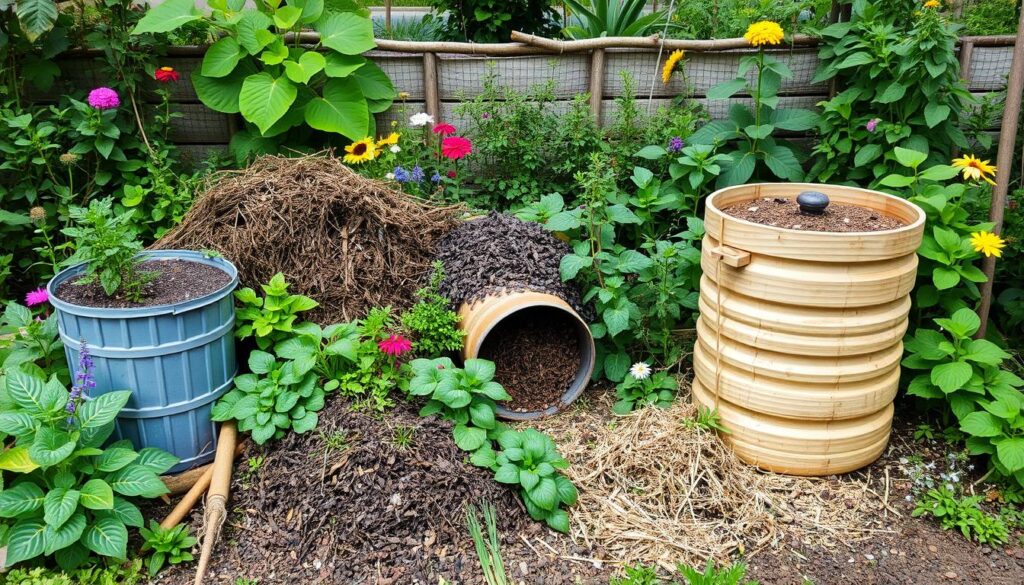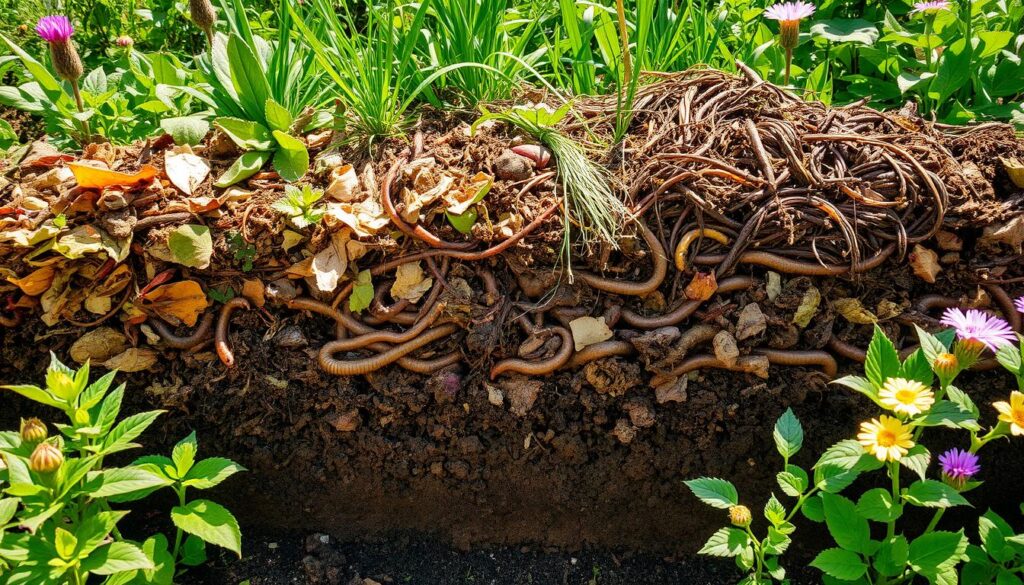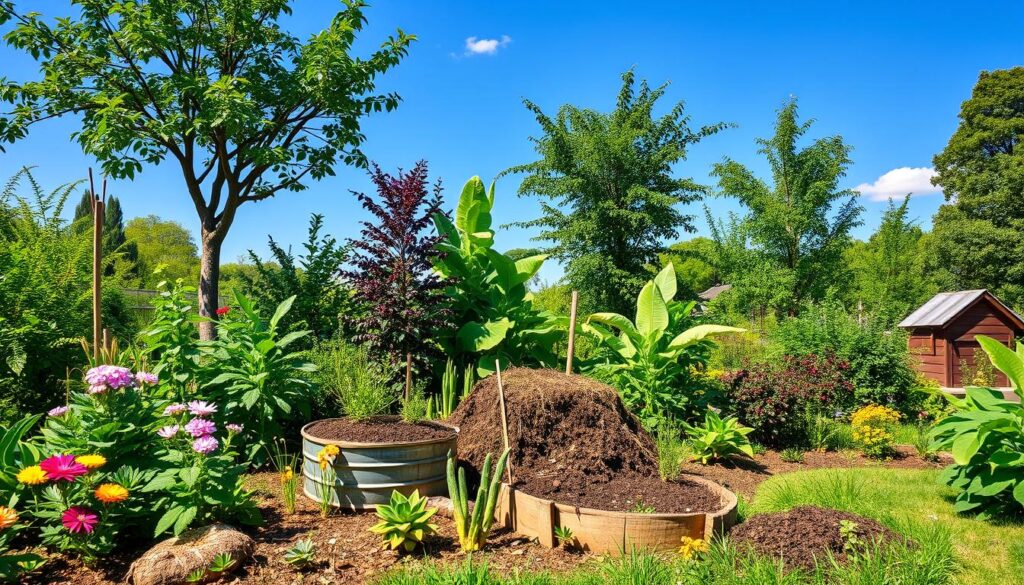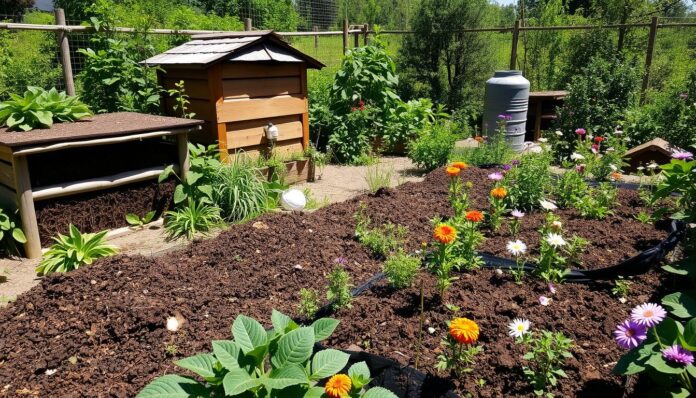Imagine cutting your household waste by up to 30% and making a nutrient-rich soil for your garden. This is possible with permaculture waste recycling and sustainable waste management. These practices involve creating efficient composting systems. Composting is key in permaculture, as it turns organic materials into a soil amendment, reducing the need for synthetic fertilizers and landfill waste.
By using eco-friendly recycling solutions, we can help the environment and live more sustainably.
Creating efficient composting systems starts with understanding permaculture. It focuses on managing waste sustainably and using local materials like cardboard and food waste for composting. This approach helps households lessen their environmental footprint and build a sustainable ecosystem. With proper design and management, composting systems can produce top-notch compost, cutting down on synthetic fertilizers and boosting plant health.
Introduction to Composting Systems
Composting systems can fit any space, from small gardens to big farms. By applying permaculture principles, we can make composting systems that cut waste and support sustainable living. Whether you’re an experienced gardener or new to it, setting up an efficient composting system is rewarding and good for the planet.
Key Takeaways
- Permaculture waste recycling and sustainable waste management practices can reduce household waste by up to 30%
- Composting is a crucial component of permaculture, recycling organic materials and reducing the need for synthetic fertilizers
- Eco-friendly recycling solutions, such as composting, can promote sustainable living and reduce environmental impact
- Efficient composting systems can be achieved by understanding permaculture principles and using locally available materials
- Composting systems can be designed to suit various needs and spaces, from small backyard gardens to large-scale agricultural operations
- Permaculture systems can reduce water usage by up to 50% compared to conventional farming practices
Understanding Permaculture and Its Principles
Permaculture is a way to design sustainable ecosystems. Nelson Lebo says composting is key on permaculture farms. It helps reduce waste and recycle materials, keeping our environment healthy.
By using permaculture, we can make composting systems that help our planet. This method is all about composting for sustainability. It turns waste into nutrient-rich soil.
Key Concepts of Permaculture
Permaculture focuses on using less chemicals and water. It also aims to increase biodiversity. These ideas help create a sustainable ecosystem.
The Role of Composting in Permaculture
Composting is crucial in permaculture. It turns waste into nutrient-rich soil. This method helps reduce waste and recycle materials, keeping our environment healthy.
Benefits of Sustainable Gardening Practices
Sustainable gardening, like permaculture, has many benefits. It includes:
- Reduced soil erosion
- Improved soil health
- Increased biodiversity
- Minimized water usage
- Reduced reliance on chemical fertilizers and pesticides
By adopting permaculture principles and practices, individuals can create a more sustainable and regenerative ecosystem, which is essential for maintaining a healthy environment.
| Permaculture Principle | Benefit |
|---|---|
| Reduce reliance on chemical fertilizers and pesticides | Decreased soil and water pollution |
| Promote biodiversity | Increased ecosystem resilience |
| Minimize water usage | Conserved water resources |
Types of Composting Systems for Permaculture
Composting is key in permaculture. It helps reduce waste and makes gardening sustainable. Using circular economy practices, people can turn waste into something useful. Morag Gamble shows how moving compost bins around the garden helps.
Permaculture offers many composting systems. You can choose from traditional bins, tumbler composters, or worm composting. Each system helps in zero waste permaculture by making waste useful. The right choice depends on your needs and goals.
Traditional Compost Bins
Traditional compost bins are popular in permaculture. They’re simple to start and keep up. They can handle many types of waste. Using them helps reduce environmental harm.

Tumbler Composters
Tumbler composters make composting easy. They help turn and aerate the compost quickly. This is great for those who want to work less but still get good compost.
Worm Composting (Vermiculture)
Worm composting, or vermicomposting, uses worms to break down waste. It’s perfect for small spaces. It turns food scraps and other waste into nutrient-rich compost. This supports plant growth and helps in a circular economy.
| Composting System | Advantages | Disadvantages |
|---|---|---|
| Traditional Compost Bins | Easy to set up, low cost | Requires regular turning and maintenance |
| Tumbler Composters | Easy to turn and aerate, fast decomposition | Higher cost than traditional compost bins |
| Worm Composting | Ideal for small-scale composting, low cost | Requires worm care and maintenance |
Designing Your Composting Space
When setting up your composting area, think about where it should be and how easy it is to get to. The right spot makes recycling waste easier and keeps things running smoothly. A good composting spot helps manage waste better and supports the environment.
Here are some important things to think about when planning your composting area:
- Proximity to a water source
- Accessibility for regular maintenance
- Adequate ventilation and aeration
- Protection from extreme weather conditions
By focusing on these points, you can make a composting area that works well. It will help with recycling waste and reduce harm to the environment.
Remember, make your composting area easy to get to and efficient. This keeps your composting system healthy and productive. It’s key for recycling waste well and managing it sustainably.
| Composting Space Design Considerations | Importance |
|---|---|
| Proximity to a water source | High |
| Accessibility for regular maintenance | High |
| Adequate ventilation and aeration | Medium |
| Protection from extreme weather conditions | Medium |
The Composting Process Explained
Composting breaks down organic materials into a nutrient-rich soil amendment. This is key for organic waste reduction and green waste recycling. It helps avoid landfills and creates a valuable resource for gardening and farming. Knowing how composting works helps make a sustainable composting system.
Nelson Lebo says, “We compost everything, including a lot of possums lately.” This shows the need for good composting methods. The composting process turns food waste and yard trimmings into a nutrient-rich soil amendment. Proper aeration and moisture management are crucial for microbial growth.
Understanding Organic Material Breakdown
The breakdown of organic materials is complex. It involves microorganisms like bacteria and fungi. These microbes feed on the materials, breaking them down into simpler compounds for plants. The breakdown process depends on temperature, moisture, and oxygen levels.

The Importance of Aeration
Aeration is vital for composting. It provides oxygen for microbes to breathe. Without enough aeration, composting can become anaerobic, causing bad smells and pathogens. Regular turning or using aeration tools helps maintain proper aeration.
Moisture Management in Compost Bins
Moisture management is also crucial. It keeps the composting environment optimal for microbes. The ideal moisture level is between 40% and 60%. Too much moisture can cause anaerobic conditions, while too little slows down the process.
Materials Required for Effective Composting
To compost well, you need a mix of green and brown materials. You also need additives to help the composting process. By knowing what materials to use, you help the environment. This supports circular economy practices and zero waste permaculture.
Morag Gamble says, “I have lots of different compost systems and ways to improve the soil.” This shows how important it is to use many materials in composting.
Green Versus Brown Materials
The right mix for compost is between 25:1 and 30:1 carbon to nitrogen by weight. You should have 1/3 ‘greens’ (nitrogen-rich) and 2/3 ‘browns’ (carbon-rich). This mix helps break down materials and makes a good compost.
Common Additives to Enhance Compost
Using many different materials in your compost makes it richer. This method is key to zero waste permaculture and green gardening.
Managing Your Compost Pile
Effective composting is key for permaculture waste recycling and sustainable waste management. By using eco-friendly recycling solutions, people can lessen their environmental impact. Tracy says, “I mix chop-and-drop and chicken wire composting,” showing the need for good compost pile management.
A well-managed compost pile helps break down organic materials efficiently. This involves turning and aerating the compost, checking temperature and moisture, and knowing about microorganisms. These steps help create a healthy composting system that supports permaculture.

Important things to consider for compost pile management include a balanced mix of “green” and “brown” materials, ensuring aeration, and watching temperature. By following these tips and using eco-friendly recycling solutions, people can improve their composting. This helps in permaculture waste recycling efforts.
Troubleshooting Common Composting Issues
Composting is key in permaculture. It helps reduce organic waste and green waste, making our environment greener. But, problems like odors and pests can happen. We can solve these by fixing our composting setup.
Nelson Lebo says it’s important to avoid bad materials in composting. For example, permaculture composting basics tell us to balance green and brown stuff. To fix a mix, aim for a 30:1 carbon to nitrogen ratio.
- Odors and pests: Make sure it’s well-aired and the mix is balanced.
- Imbalanced compost mix: Add brown stuff for more carbon or green stuff for more nitrogen.
- Slow composting: Check the temperature and moisture, and turn it often.
By solving common composting problems, we can make a system that’s good for our planet. It helps reduce organic waste and green waste. This supports composting for sustainability.
Integrating Compost Into Your Permaculture Design
Exploring permaculture shows us how vital compost is for a sustainable ecosystem. By using circular economy practices, we help the environment. This means turning waste into something useful through waste-to-resource initiatives.
Morag Gamble found that a compost bin can really help your garden. It shows how important compost is in permaculture. Key steps include:
- Adding compost to garden beds for better soil
- Making compost tea for plant health
- Using finished compost for soil fertility
These steps help your garden grow strong and waste-free. They also boost biodiversity and ecosystem services. Remember, composting is part of a bigger effort for a greener future.
By following these principles, you make your permaculture system productive and regenerative. This leads to a healthier environment and a sustainable future.
| Compost Integration Methods | Benefits |
|---|---|
| Using compost in garden beds | Improves soil structure and fertility |
| Creating compost tea | Boosts plant health and immune system |
| Enhancing soil fertility with finished compost | Promotes healthy plant growth |
Scaling Composting Systems for Larger Projects
As more people seek green waste solutions, making composting systems bigger is key. This means using permaculture and eco-friendly ways to handle lots of organic waste. In 2014, the U.S. Environmental Protection Agency said only 5.1% of food scraps were recycled.
Community composting is a big help. It aims to use food scraps, cut down waste, and help soil and local food. These projects can reach different areas, teaching people about green waste management. By joining these efforts, we can help the planet and make waste management better.

Scaling up composting brings many benefits:
* Better waste handling
* Less pollution
* Nutrient-rich compost for farms and nature
* Support for local green projects and learning
| Composting System | Benefits | Challenges |
|---|---|---|
| Community Composting | Local resource recovery, job creation, education | Space requirements, odor management, contamination risks |
| Commercial Permaculture Operations | Large-scale waste management, economic benefits, eco-friendly products | High initial investment, complex logistics, regulatory compliance |
Knowing the ups and downs of bigger composting helps us work together. We can build green, growing ecosystems. This supports permaculture and eco-friendly recycling.
Maintaining a Healthy Composting System
Keeping a composting system healthy is key for organic waste reduction and green waste recycling. Nelson Lebo says, “We compost everything, including a lot of possums lately.” This shows how vital a healthy composting system is. It helps create a sustainable and regenerative ecosystem.
To keep your composting system in top shape, make seasonal adjustments for care. Watch the temperature and moisture levels. Also, turn and aerate the compost pile often. Fungi play a big role in breaking down organic matter and making nutrient-rich compost.
Here are some tips for a healthy composting system:
- Monitor temperature and moisture levels
- Turn and aerate the compost pile regularly
- Add a mix of “green” and “brown” materials to the compost pile
- Avoid adding meat, dairy, and oils to the compost pile
By following these tips and adjusting seasonally, you can have a healthy composting system. This system helps reduce organic waste and recycle green waste. It supports composting for sustainability and makes our community more eco-friendly.
| Composting Material | Carbon to Nitrogen Ratio |
|---|---|
| Sawdust | 500:1 |
| Fish | 7:1 |
| Urine | 1:1 |
Composting and Soil Health Connection
Composting is key to keeping soil healthy. It’s vital for sustainable and regenerative ecosystems. By using circular economy practices, we can cut down on waste and support zero waste permaculture. Morag Gamble says, “Healthy soil means healthy plants and easier food growth.”
This link between composting and soil health is essential for a sustainable ecosystem. Compost makes soil better, helps nutrients cycle, and builds strong ecosystems. Some composting benefits include:
- Increasing soil organic matter by 5-10% in two years
- Lowering soil erosion by 90% with no-till methods
- Boosting soil fertility by encouraging diverse nutrient uptake
By starting waste-to-resource initiatives and composting, we help make soils healthier. This supports circular economy practices and helps grow food sustainably.
Future Trends in Permaculture Composting Systems
The world is moving towards more sustainable ways. Permaculture waste recycling and eco-friendly recycling solutions are key. Tracy says, “The best composting method is the one that works for you and fits your garden and climate.”
New composting technologies are making it easier to recycle waste. For instance, permaculture animal welfare supports regenerative grazing and ethical farming. Teaching the next generation about composting is vital for a sustainable future.
Some major trends in permaculture composting include:
- New composting tech like worm and bokashi composting
- Teaching the next gen about composting and waste management
- Sharing global sustainable composting practices
By using permaculture waste recycling, we can help our planet. Eco-friendly solutions like composting reduce waste and make our environment better.
| Composting Method | Benefits |
|---|---|
| Worm Composting | High-quality compost, low maintenance |
| Bokashi Composting | Fast decomposition, minimal odor |
Conclusion: Embracing Efficient Composting Systems
Embracing efficient composting systems is key for a sustainable future. It helps us create a better environment. By working together, we can reduce waste and make our gardens healthier.
Composting is a step towards a greener world. Nelson Lebo says, “Peace, Estwing (Nelson Lebo),” showing its importance. Together, we can make a big difference by composting.
Starting small is the first step towards a sustainable future. You can start a compost bin at home or join a local composting group. Every action helps make our world a better place. Let’s work together to make a positive change.

